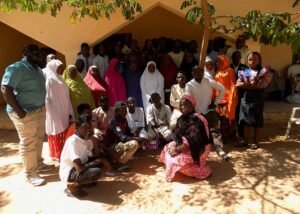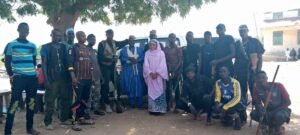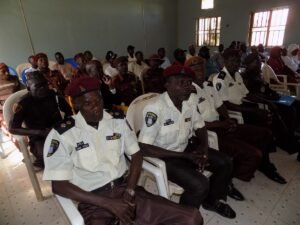Transformational Effect of Training in Nonviolent Communication:
A Case Study of Training of Vigilante Groups in Yobe State, Northeast Nigeria
International Journal of Peace, Education and Development Citation: IJPED: 10(01): 01-07, June 2022
DOI: 10.30954/2454-9525.01.2022.2
Peer Reviewed Journal
ABSTRACT
Vigilantes in Nigeria are known to compliment the work of security agencies. They are widely spread across the state and have contributed enormously to stability in many communities, local government areas, and the state. They vary in organizational structure and have names based on location and context. In places where there are no formal state actors (security), the vigilante, in collaboration with community leaders, forms a structure of policing within the community to maintain law and order. Over the years, with the rise in an insurgency, the relevance of vigilantes has become more pronounced, and they support security operatives during formal engagements. The knowledge and the practical understanding that the vigilantes possess help in finding a solution to many complex problems. As they support community safety, there are often gaps in how the vigilantes relate to or respond to security matters within the community since most of them do not have formal training before joining the vigilante group. In this context, training in peace-building and conflict de-escalation is essential. In this backdrop, this paper explores the transformational effect of training vigilantes in the Gandhian model of nonviolent communication. It captures the impact of a sustained training program organized for vigilantes in Yobe, north-eastern Nigeria.
Introduction

Yobe state is located in north-eastern Nigeria and shares borders with the Republic of Niger to the north and the Nigerian states of Borno to the east, Gombe to the south-west, Bauchi to the west, and Jigawa to the northwest. Damaturu is the state capital, while Geidam, Potiskum, and Gashua are sizable market towns.
The state is served by trunk roads connecting Potiskum, Damaturu, and Maiduguri (in Borno state) in its central part. It has a population of about 2,321,591 according to the 2006 population census. Yobe state has 17 Local Government Areas (LGAs), which are divided into three senatorial districts/ Zones: Zone A (Damaturu, Gulani, Gujba, Geidam, Tarmuwa, Bursari, Yunusari, and Yusufari), Zone B (Potiskum, Fika, Nangereand Fune), Zone C (Nguru, Bade, Karasuwa, Jakusko, and Machina).
Most visible tribes include Kanuri, Karai-Karai, Ngizim, Ngamo, Hausa, Fulani, Bolewa, Bura, and Manga. Nigeria has a long history of having vigilante groups. They have been there not only during civilian rule but also during periods when there have been military governments. For instance, they were there during the military dictatorship of Generals Babangida, Abacha, and Abubakar. Traditionally, the vigilantes have been seen as an extension of the work of law enforcement officers. Nigeria can be said to have high levels of delinquency.
Also, a significant challenge is the severe lack of training of police personnel. There are inadequate equipment and personnel. An Amnesty International report (2002) talking about the phenomenon of vigilantes in Nigeria shares the different forms of vigilantes in the country. It notes, “For instance, in south-eastern Nigeria there traditionally existed groups commonly known as “Ndinche”, community guards formed by volunteers in villages who would bring suspected criminals to the community council, often called “Amala”, and then display them in front of the village to their shame before being handed over to the police.” The report talks about how from the late 1980s and almost the whole of the 1990s, the military governments established anti-crime squads, which included soldiers, policemen, and vigilante groups. These vigilante groups were mostly comprised of armed civilians. However, this starkly contrasted to the traditional concept of vigilante in Nigeria.

The whole grounding of the vigilante concept in Nigerian society was how unarmed voluntary citizen groups were created in local communities to aid and help security forces. The aim was to help the security forces handle common criminality and social violence. The vigilantes are also expected to arrest suspected delinquents and hand them over to the police. If we look at the law in Nigeria, it provides recognition to vigilante groups arresting suspected criminals if they are unarmed and the suspect is immediately handed over to the police.
According to the Amnesty Report, a major fall-out in the post-military regime has been the increasing incidence of crime. This has paved a fertile ground for the proliferation of ‘heavily armed vigilante groups of various conditions and interests in nearly every corner of Nigeria’. Meanwhile, Badiora (2022), talking about the history of vigilantism in Nigeria notes, “In the Yorubaspeaking south-west, crime-fighting has been led by the O’odua People’s Congress; in the eastern states by the Bakassi Boys; and across the north by Shari’a implementation committees or Hisba”. Badiora talks about two ways of approaching the phenomenon of vigilantism. There was one approach where community and self-help policing groups protected the public through different law enforcement styles of policing.
The other approach can be described as violent vigilantism as it took the form of extra-judicial killing as which meant the killing of people by groups of citizens without having the authority of government. In his study of vigilantes, Bandiora found that most people felt on the need of vigilantes’ to acknowledge ‘the basic dignity and rights of citizens. His study underlined the need of vigilantes to make all their decisions ‘in a neutral and objective way’.
The study findings stressed that all cost vigilantes should avoid all kinds of brutal and violent methods of dealing with offenders. His findings also suggest, “The government should devise performance guidelines and supervisory mechanisms for vigilantism or non-state institutions wherever they exist.” The study underscored the urgent need to develop frameworks of policing standards that could guide the performance of vigilantes, develop standardized procedures, and define the jurisdictions and the type of interventions they can make. Bandiora’s study points out, “If procedural justice were to be used in dealing with the public, support for and satisfaction with vigilantes could become widespread in the society.”
The authors as part of an initiative to strengthen the functioning of vigilantes by Hope Interactive in collaboration with the Conciliation Resources (UK) have mapped vigilante groups in Yobe state. It was found that these included:
- Vigilante Group of Nigeria (VGN) – Armed; ~ State Level (Coordinated by State Government). ~ LGA Level (Coordinated by Local Government).
- Hunters Group (Armed).
- War Against Indiscipline (WAI) Brigade (Unarmed).
During the mapping exercise and in the context of Bandiora’s study, it was found that vigilantes’ need to be exposed to capacity-building programs where they can assimilate the principles of procedural justice, understand the importance of human dignity and human rights, approach disputes through a nonviolent way and engage the community at large to be more effective.
It was found that for greater effectiveness, vigilantes’ should be given training in nonviolent communication to engage with the public at large. It was also found that poor communication have been a major factor creating a gap between vigilante and community members, as they play a vital role in conflict resolution in most societies.

In this context, it was felt that training in nonviolent communication could be an effective strategy for delivering procedural justice and upholding the citizenry’s dignity. It is in this backdrop that Hope Interactive conducted a series of capacity-building training of vigilantes in nonviolent communication. The first round of training in nonviolent communication was at the state level, where vigilante officials (leaders) were taught the concept of nonviolent communication, its various dimensions, and elements. To broaden the coverage across the local government areas (LGAs), five LGAs were selected for the first round of training. Besides, nine communities from the local government areas (LGA) were also included. These included: Gujba LGA (Kasatchiya and Railway communities), Damaturu LGA (Ajari and Pompomari communities), Fune LGA (Dogo Kuka and Daura communities), Potiskum LGA (Sabon Tasha community), Gaidam LGA (Anguwam Kwari and Kasuwam Shanu communities).
In each community, 30 vigilantes took part in the training making a total of 270 junior officers in nine communities across five LGAs. The training methodology used for the community level training was the same as that of the state level. The training was simplified for the junior officers as their educational qualifications and experience were a bit lower than their senior officials. At the state-level training, the senior officers were encouraged to contribute to the training process during the training of junior vigilante officers. This was to ensure the sustainability of nonviolent communication training and a sense of ownership among the senior officers. To understand the impact of the training programme, a feedback system was developed. After 15 days of the training, the participants were asked how they could use the different elements of nonviolent communication in their work.
This chapter will study the transformational effect of the training programme on nonviolent communication amongst vigilantes’. Essentially the Gandhian approach to nonviolent communication was used for the training purpose.
ACKNOWLEDGEMENT
Special thanks to the West Africa program (WAP) team of Conciliation Resources (Mrs Janet Adama Mohammed and Mr. Daniel Tucker) for the inestimable support they provided during the implementation of Smart peace and Voice of all for peace (Ra’ayin Kowa a zaman lafiya) projects.


Transformational Effect of Training in Nonviolent Communication:
A Case Study of Training of Vigilante Groups in Yobe State, Northeast Nigeria
International Journal of Peace, Education and Development Citation: IJPED: 10(01): 01-07, June 2022
DOI: 10.30954/2454-9525.01.2022.2
Peer Reviewed Journal
ABSTRACT
Vigilantes in Nigeria are known to compliment the work of security agencies. They are widely spread across the state and have contributed enormously to stability in many communities, local government areas, and the state. They vary in organizational structure and have names based on location and context. In places where there are no formal state actors (security), the vigilante, in collaboration with community leaders, forms a structure of policing within the community to maintain law and order. Over the years, with the rise in an insurgency, the relevance of vigilantes has become more pronounced, and they support security operatives during formal engagements. The knowledge and the practical understanding that the vigilantes possess help in finding a solution to many complex problems. As they support community safety, there are often gaps in how the vigilantes relate to or respond to security matters within the community since most of them do not have formal training before joining the vigilante group. In this context, training in peace-building and conflict de-escalation is essential. In this backdrop, this paper explores the transformational effect of training vigilantes in the Gandhian model of nonviolent communication. It captures the impact of a sustained training program organized for vigilantes in Yobe, north-eastern Nigeria.
Introduction
Yobe state is located in north-eastern Nigeria and shares borders with the Republic of Niger to the north and the Nigerian states of Borno to the east, Gombe to the south-west, Bauchi to the west, and Jigawa to the northwest. Damaturu is the state capital, while Geidam, Potiskum, and Gashua are sizable market towns.
The state is served by trunk roads connecting Potiskum, Damaturu, and Maiduguri (in Borno state) in its central part. It has a population of about 2,321,591 according to the 2006 population census. Yobe state has 17 Local Government Areas (LGAs), which are divided into three senatorial districts/ Zones: Zone A (Damaturu, Gulani, Gujba, Geidam, Tarmuwa, Bursari, Yunusari, and Yusufari), Zone B (Potiskum, Fika, Nangereand Fune), Zone C (Nguru, Bade, Karasuwa, Jakusko, and Machina).
Most visible tribes include Kanuri, Karai-Karai, Ngizim, Ngamo, Hausa, Fulani, Bolewa, Bura, and Manga. Nigeria has a long history of having vigilante groups. They have been there not only during civilian rule but also during periods when there have been military governments. For instance, they were there during the military dictatorship of Generals Babangida, Abacha, and Abubakar. Traditionally, the vigilantes have been seen as an extension of the work of law enforcement officers. Nigeria can be said to have high levels of delinquency.
Also, a significant challenge is the severe lack of training of police personnel. There are inadequate equipment and personnel. An Amnesty International report (2002) talking about the phenomenon of vigilantes in Nigeria shares the different forms of vigilantes in the country. It notes, “For instance, in south-eastern Nigeria there traditionally existed groups commonly known as “Ndinche”, community guards formed by volunteers in villages who would bring suspected criminals to the community council, often called “Amala”, and then display them in front of the village to their shame before being handed over to the police.” The report talks about how from the late 1980s and almost the whole of the 1990s, the military governments established anti-crime squads, which included soldiers, policemen, and vigilante groups. These vigilante groups were mostly comprised of armed civilians. However, this starkly contrasted to the traditional concept of vigilante in Nigeria.
The whole grounding of the vigilante concept in Nigerian society was how unarmed voluntary citizen groups were created in local communities to aid and help security forces. The aim was to help the security forces handle common criminality and social violence. The vigilantes are also expected to arrest suspected delinquents and hand them over to the police. If we look at the law in Nigeria, it provides recognition to vigilante groups arresting suspected criminals if they are unarmed and the suspect is immediately handed over to the police.
According to the Amnesty Report, a major fall-out in the post-military regime has been the increasing incidence of crime. This has paved a fertile ground for the proliferation of ‘heavily armed vigilante groups of various conditions and interests in nearly every corner of Nigeria’. Meanwhile, Badiora (2022), talking about the history of vigilantism in Nigeria notes, “In the Yorubaspeaking south-west, crime-fighting has been led by the O’odua People’s Congress; in the eastern states by the Bakassi Boys; and across the north by Shari’a implementation committees or Hisba”. Badiora talks about two ways of approaching the phenomenon of vigilantism. There was one approach where community and self-help policing groups protected the public through different law enforcement styles of policing.
The other approach can be described as violent vigilantism as it took the form of extra-judicial killing as which meant the killing of people by groups of citizens without having the authority of government. In his study of vigilantes, Bandiora found that most people felt on the need of vigilantes’ to acknowledge ‘the basic dignity and rights of citizens. His study underlined the need of vigilantes to make all their decisions ‘in a neutral and objective way’.
The study findings stressed that all cost vigilantes should avoid all kinds of brutal and violent methods of dealing with offenders. His findings also suggest, “The government should devise performance guidelines and supervisory mechanisms for vigilantism or non-state institutions wherever they exist.” The study underscored the urgent need to develop frameworks of policing standards that could guide the performance of vigilantes, develop standardized procedures, and define the jurisdictions and the type of interventions they can make. Bandiora’s study points out, “If procedural justice were to be used in dealing with the public, support for and satisfaction with vigilantes could become widespread in the society.”
The authors as part of an initiative to strengthen the functioning of vigilantes by Hope Interactive in collaboration with the Conciliation Resources (UK) have mapped vigilante groups in Yobe state. It was found that these included:
During the mapping exercise and in the context of Bandiora’s study, it was found that vigilantes’ need to be exposed to capacity-building programs where they can assimilate the principles of procedural justice, understand the importance of human dignity and human rights, approach disputes through a nonviolent way and engage the community at large to be more effective.
It was found that for greater effectiveness, vigilantes’ should be given training in nonviolent communication to engage with the public at large. It was also found that poor communication have been a major factor creating a gap between vigilante and community members, as they play a vital role in conflict resolution in most societies.
In this context, it was felt that training in nonviolent communication could be an effective strategy for delivering procedural justice and upholding the citizenry’s dignity. It is in this backdrop that Hope Interactive conducted a series of capacity-building training of vigilantes in nonviolent communication. The first round of training in nonviolent communication was at the state level, where vigilante officials (leaders) were taught the concept of nonviolent communication, its various dimensions, and elements. To broaden the coverage across the local government areas (LGAs), five LGAs were selected for the first round of training. Besides, nine communities from the local government areas (LGA) were also included. These included: Gujba LGA (Kasatchiya and Railway communities), Damaturu LGA (Ajari and Pompomari communities), Fune LGA (Dogo Kuka and Daura communities), Potiskum LGA (Sabon Tasha community), Gaidam LGA (Anguwam Kwari and Kasuwam Shanu communities).
In each community, 30 vigilantes took part in the training making a total of 270 junior officers in nine communities across five LGAs. The training methodology used for the community level training was the same as that of the state level. The training was simplified for the junior officers as their educational qualifications and experience were a bit lower than their senior officials. At the state-level training, the senior officers were encouraged to contribute to the training process during the training of junior vigilante officers. This was to ensure the sustainability of nonviolent communication training and a sense of ownership among the senior officers. To understand the impact of the training programme, a feedback system was developed. After 15 days of the training, the participants were asked how they could use the different elements of nonviolent communication in their work.
This chapter will study the transformational effect of the training programme on nonviolent communication amongst vigilantes’. Essentially the Gandhian approach to nonviolent communication was used for the training purpose.
ACKNOWLEDGEMENT
Special thanks to the West Africa program (WAP) team of Conciliation Resources (Mrs Janet Adama Mohammed and Mr. Daniel Tucker) for the inestimable support they provided during the implementation of Smart peace and Voice of all for peace (Ra’ayin Kowa a zaman lafiya) projects.